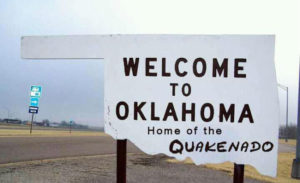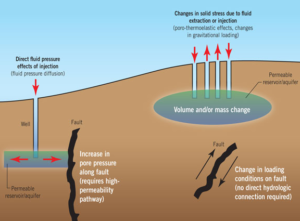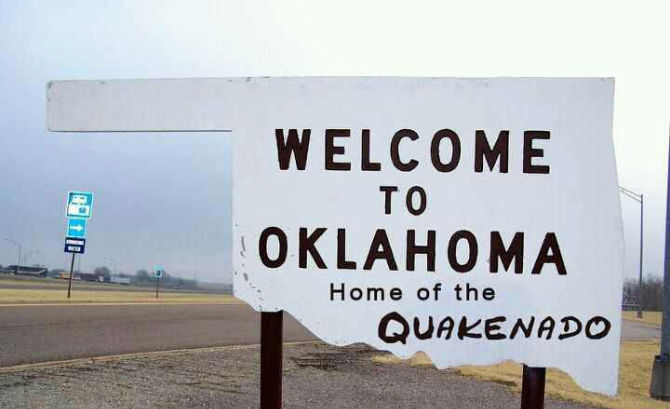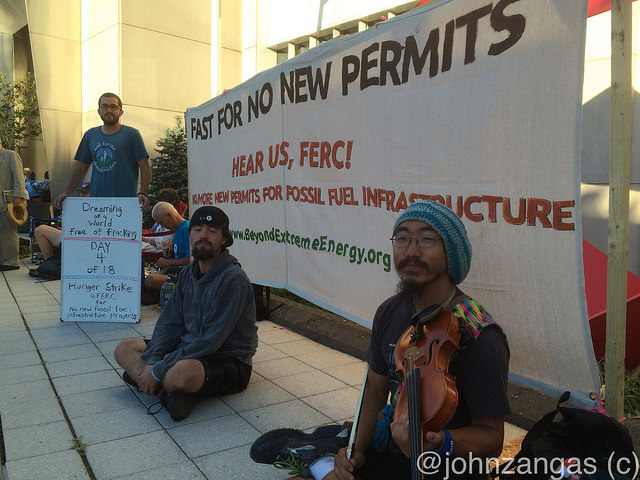 Oklahoma officials were hoping they had found the right policy balance that would reduce the number of earthquakes but also not harm the economic health of the state’s dominant oil and gas industry. At mid-year, Oklahoma had seen 403 earthquakes of magnitude 3.0 or above, which put the state on pace to experience fewer earthquakes of that magnitude for the entire year compared to 2015.
Oklahoma officials were hoping they had found the right policy balance that would reduce the number of earthquakes but also not harm the economic health of the state’s dominant oil and gas industry. At mid-year, Oklahoma had seen 403 earthquakes of magnitude 3.0 or above, which put the state on pace to experience fewer earthquakes of that magnitude for the entire year compared to 2015.
But then Saturday’s powerful 5.6-magnitude earthquake struck north-central Oklahoma, creating confusion about the effectiveness of the state’s efforts to limit the volume of oil and natural gas industry-related wastewater injected into deepwater disposal wells. The Sept. 3 earthquake, whose epicenter was located near Pawnee, Okla., equaled the magnitude of the state’s strongest quake on record, another manmade temblor that hit Prague, Okla., in November 2011.
“While earthquakes have been down overall, larger quakes — magnitude-4.0 or greater — have happened at the same rate or higher,” said Mike Soraghan, a reporter with EnergyWire and one of the leading journalists covering the growing number of manmade earthquakes in Oklahoma and other oil and gas producing states.
By August 2015, 17 earthquakes of magnitude-4 or greater had struck Oklahoma. The same number of equally strong earthquakes had hit Oklahoma over the same time period in 2016, although in July and August of this year, the state had seen seven earthquakes of magnitude-4 or greater, compared to five such quakes in those same two months in 2015.
Earlier this summer, state officials were quick to take credit for the decrease in earthquakes. “The incidence of earthquakes is down, and that’s attributed to decreased injections,” Oklahoma Geological Survey Director Jeremy Boak said in a July interview with energy news service Platts.
Soraghan hesitates to attribute the decline solely to Oklahoma’s efforts to reduce the amount of disposal wells in certain areas of the state. “A lot has been said about new restrictions on disposal being the reason for the drop in moderate-sized quakes,” Soraghan said in an interview. “But nobody really knows how much of the decrease we have seen can be attributed to those regulatory restrictions and how much is the slowdown in the industry.”
In July, Soraghan said the Oklahoma Geological Survey (OGS) told him that in the earthquake-prone northwest and north-central parts of the state, companies had cut disposal by about 500,000 barrels a day beyond the state’s directives. If oil and gas drilling were to pick up again in tandem with a rise in commodity prices, the disposal companies could increase the volume of oil and gas wastewater disposal with violating the state’s directives, he said.
A New Year’s Eve 2011 earthquake in Ohio is the one that drew Soraghan’s attention to manmade earthquakes. “Manmade earthquakes? Are you kidding me?” he remembers thinking at the time.
Soraghan, who worked for The Hill and The Denver Post newspapers prior to joining E&E Publishing’s EnergyWire in 2010, recalls that it took Oklahoma officials several years to concede that the deepwater injection of wastewater from oil and gas drilling was the likely cause of the incredible rise in earthquakes in the state.
Earthquakes Hit Oklahoma in Swarms
A magnitude-5.6 quake — the largest in state history — struck Prague, Okla., late at night on Nov. 5, 2011. The quake was preceded by a magnitude-4.8 earthquake early that morning, and a 4.8 aftershock struck two days later. More than 174 homes in Lincoln and Pottawatomie counties, Okla., sustained damage, including six destroyed.
The Oklahoma Geological Survey (OGS) recorded 64 earthquakes of magnitude-3.0 or greater by the end of 2011. Seismic activity began to pick up in 2013 when the OGS reported 109 earthquakes of magnitude-3.0 or higher for the year. Disposal well-induced earthquakes increased dramatically in 2014 when the state reported 585 earthquakes of magnitude-3.0 or greater followed by 907 such temblors in 2015.

In April 2015, the OGS finally issued a declaration conceding that “the majority of recent earthquakes in central and north-central Oklahoma are very likely triggered by the injection of produced water in disposal wells.”
Earlier this year, the Oklahoma Corporation Commission (OCC), which has regulatory authority over the state’s oil and gas industry, announced actions to reduce the amount of oil and gas wastewater injected into Arbuckle formation disposal wells in earthquake areas. According to researchers, wastewater injection into the Arbuckle geological formation poses the greatest potential risk for earthquakes in Oklahoma.
“Looking back, it’s reasonable to ask whether some of what’s happening now could have been avoided if Oklahoma’s elected officials had acted more quickly,” Soraghan said. “And there’s indications from my reporting and that of other news organizations that some of the delay was not simply the result of scientific uncertainty.”
Seismologists who are studying the dramatic spike in earthquakes in Oklahoma explain that for every number of magnitude-3 earthquakes, the region will experience a smaller number of magnitude-4 earthquakes. As the number of magnitude-4 earthquakes increases, the region will experience a certain number of magnitude-5 earthquakes. If magnitude-5 earthquakes become more commonplace, then the likelihood of magnitude-6 earthquakes in the state will become more likely.
Based on his conversations with experts, Soraghan found that the outer limit for earthquakes in Oklahoma is likely a magnitude-7 earthquake, which would be devastating for the state, especially if the epicenter were located near a densely populated area.
The greatest number of magnitude-3 or greater earthquakes has occurred in the more sparsely populated northwest region of Oklahoma in small towns like Medford and Fairview. “You can have a strong earthquake out in Medford or even further out in Fairview, it gets a lot less reaction than a small magnitude earthquake in Edmond,” Soraghan said. “If you get a magnitude-4 in Edmond, all of sudden everyone in Oklahoma is paying attention. You get a 5.1 in Fairview, I don’t think it made the front page of the Oklahoma City newspaper.”
Even Texas Adopts More Aggressive Stance
Oklahoma has adopted a less-aggressive approach toward human-caused tremors than states like Texas and Ohio. “In Oklahoma, you’ve had a less strong reaction than even in Texas,” said Soraghan, who pointed to a series of relatively small earthquakes in Azle, Texas, northwest of Fort Worth, that caused a much stronger reaction from local and state officials than the more powerful earthquakes in Oklahoma.
Ohio also reacted swiftly to earthquakes that have been caused by both wastewater disposal wells and the use of hydraulic fracturing. A study published in the Bulletin of the Seismological Society of America in 2015 attributed nearly 80 earthquakes that occurred in Mahoning County, Ohio, in March 2014 to nearby hydraulic fracturing operations, not wastewater disposal wells. In Oklahoma, on the other hand, experts agree that the earthquakes that are occurring in large swarms are caused almost exclusively by disposal wells.
“In Oklahoma, you can draw a line on the outrage meter basically by population density. Medford, which is more than an hour outside Oklahoma City, just got hammered and hammered for a long time. You didn’t hear a lot of uproar out of there. But when you started having earthquakes hit Edmond, a suburb of Oklahoma City, you could certainly see a lot more reaction and TV cameras heading there,” he said.
Despite its strength, which could be felt in several states beyond Oklahoma, Soraghan doesn’t believe the latest 5.6-magnitude earthquake will lead to many changes in policy in Oklahoma. “They’re at the outer limits of what they can do in their current structure,” he said. “They need a lot more push from the governor and an incentive to use that power from the rest of the political structure in the state.”
This article was originally published on Counterpunch.





